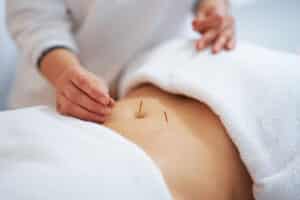Proudly part of the City Fertility Network
Proudly part of the City Fertility Network
Complementary therapies in IVF refers to alternative IVF therapies and practices that are used alongside standard assisted reproductive technology to add a holistic approach to fertility care. Therapies such as acupuncture, yoga, meditation and herbal medicine supports treatment with the aim to improve pregnancy success rates as well the many benefits of improved physical health and mental wellbeing.
Couples who combine complementary IVF therapies into their IVF treatment often report feeling calmer, emotionally stronger and more able to cope with the demands of IVF These therapies may help them to have a more positive outlook about their fertility journey.
It is important to understand that many complementary medicines have little or no supporting evidence on their effectiveness, risks and side effects. Despite this, your fertility specialist may recommend these treatments to you based on your medical history and previous treatment outcomes.
Acupuncture is a branch of traditional Chinese medicine that dates back thousands of years. It involves the insertion of fine needles into specific points on the body to produce a therapeutic effect. Acupuncture is a very popular complementary therapy to support IVF.

Acupuncture for IVF may offer the following benefits:
There are usually no side effects associated with acupuncture and there is little discomfort from the procedure itself. It’s important to consult with your fertility specialist and a qualified acupuncturist with expertise in managing infertility to understand how acupuncture might benefit your IVF journey.
Yoga is a powerful complementary practice that can support fertility treatment. One of the most pervasive mind-body challenges for couples undertaking fertility treatment is stress and feeling “out of control”. Stress hormones generate chemicals that weaken the body’s immunity and suppress fertility hormones, which may impair conception. Although there is little direct evidence to suggest that practicing yoga will guarantee pregnancy, the known benefits of relaxation, mindfulness and breathing can reduce emotional and physical stress.
Key benefits include:

If you are experiencing infertility and want to integrate yoga into your IVF treatment, we suggest you consider restorative yoga practice or fertility focused classes which will avoid strain on the abdominal area.

Meditation and mindfulness can serve as empowering processes that can be used while undergoing fertility treatment. The relationship between stress and infertility is complex. There is minimal evidence that anxiety contributes significantly to infertility, but increasing research that depression may.
Key benefits include:

Selected essential oils used in conjunction with massage therapy may help by:
Couples may find that using essential oils at home and regular aromatherapy massages help to provide physical and emotional support when planning for a baby. Always consult a qualified therapist for advice and guidance before using essential oils. Some oils may not be safe to use while trying to conceive and during pregnancy.

If you are taking herbal supplements, or your partner is, please advise your clinician. If you are interested in making herbal therapies part of an integrated health plan before or in between IVF treatments, contact the National Herbalists Association of Australia (NHAA) for a list of qualified practitioners in your area.
Request an appointment with one of our specialists.Book your appointment